Invited Speakers
Semantic Web-based Knowledge Management for Mobile Services
(Prof. Rachid Benlamri -Lakehead University, Ontario - Canada)Software Testing and Quality Assurance - why the progress is so slow?
(Prof. Narayan C. Debnath - Winona State University - USA)Dynamic Spectrum Access Wireless Networks: From Policies to Practice
(Prof. R. Chandramouli - Stevens Institute of Technology, Hoboken, NJ - USA)The Bio-Logic of Artificial Creatures
(Prof. Yves Duthen - University of Toulouse 1-Capitole - France)The complexity of distributed algorithms
(Prof. Rachid Guerraoui -École polytechnique fédérale de Lausanne, Lausanne - Switzerland)Review of Sensing Techniques for Cognitive Radio Systems
(Prof. Aawatif Hayar - GREENTIC/ENSEM, Hassan II University, Casablanca - Morocco)Multimedia standards: History - State of Art
(Prof. Peter Stanchev - Kettering University, Michigan - USA)Are Dynamic Spectrum Access Networks Secure?
(Prof. K.P. Subbalakshmi - Stevens Institute of Technology, Hoboken, NJ - USA)
Semantic Web-based Knowledge Management for Mobile Services
The ability to grasp the exact knowledge required to perform specific task, anywhere and just-in-time, is a key requirement for organizations to remain competitive in the new knowledge society. Therefore, the issues of “mobility” and “Knowledge Management” have recently received much attention among the research community. The interest in these issues is often motivated by the fact that work in many organizations is “knowledge intensive” and “mobile”. Activities involving for instance e-healthcare; mobile-learning, environmental monitoring; and remote tracking for safety and homeland security require special infrastructure for mobile knowledge management tailored to the context of their users and surrounding environment. Advances in wireless communications, semantic Web technologies, sensor networks, ubiquitous and mobile computing offer unique chances to build such infrastructure, thus enabling higher levels of interoperability and automation across broad range of context-aware mobile services. Such services can dynamically recognize and adapt to the context in which their users operate (e.g. location, activity, surrounding environment, social context, etc…), and reconciliate the interoperability and confidentiality requirements associated with users’ needs. In this talk, we present recent progress in this field with a focus on context awareness issues in mobile services. In particular, we show the use of ontologies to model context information in a service oriented mobile environment. Case studies in m-learning and mobile e-healthcare will be presented.
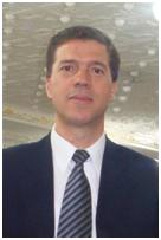
Rachid Benlamri, Ph.D., P.Eng., Professor and Chair
Department of Software Engineering
Faculty of Engineering
Lakehead University
955 Oliver Rd - Thunder Bay
Ontario - P7B 5E1
Office: ATAC 5016
Tel: +1 (807) 346 7960
rbenlamr@lakeheadu.ca
http://flash.lakeheadu.ca/~rbenlamr
Professor Rachid Benlamri is the Chair of the Software Engineering Department at Lakehead University, Canada. He is also the Chief Operation Officer of Bitcold Technology Inc., a startup company specialized in e-Healthcare technologies (www.bitcold.com). He graduated from the Computer Science Department at the University of Manchester - UK in 1990. His research interests are in the area of Semantic Web, Context-Aware Computing, Ubiquitous Computing, Mobile Knowledge Management, and Semantic Video Analysis. His research is supported by many funding institutions such as the Natural Sciences and Engineering Research Council of Canada (NSERC), Northern Ontario Heritage Fund Corporation (NOHFC), Academic Health Science Centers (AHSC) of Ontario, and the Ontario Partnership for Innovations and Commercialization (OPIC). He supervised over 70 students and postdoctoral fellows. He served as keynote speaker for many international conferences. He was the general chair for the 5th International Conference on Digital Information Management (ICDIM2010), and he is currently chairing the 4th International Conference on Networked Digital Technologies (NDT’2012). He also organized and chaired many international workshops on various topics including ubiquitous computing, context-aware computing, and mobile learning. Prof. Benlamri is an Associate Editor for the International Journal of Ubiquitous Learning, and member of the editorial board of many other journals such as the International Journal of Learning Technologies, the International Journal of Mobile Communications, the International Journal of Emerging Technologies in Web Intelligence, and the International Journal of Electronic Government.
The complexity of distributed algorithms
This talk will review the history of distributed computing and highlight some of its main open challenges

Rachid Guerraoui
Professor
School of Computer and Communication Sciences (LPD)
École polytechnique fédérale de Lausanne,
Lausanne, Switzerland
LPD (Station 14), I&C, EPFL CH 1015 Lausanne, Switzerland - Office INR 310 -
Tel +41 21 693 5272 - Fax +41 21 693 75 70
rachid.guerraoui@epfl.ch
http://lpd.epfl.ch/rachid/
Rachid Guerraoui has been affiliated with Ecole des Mines of Paris, the Commissariat à l'Energie Atomique of Saclay, Hewlett Packard Laboratories and the Massachusetts Institute of Technology. He has worked in a variety of aspects of distributed computing, including distributed algorithms and distributed programming languages. He is most well known for his work on (e-)Transactions, epidemic information dissemination and indulgent algorithms.
He co-authored a book on Transactional Systems (Hermes) and a book on reliable distributed programming (Springer). He was appointed program chair of ECOOP 1999, ACM Middleware 2001, IEEE SRDS 2002, DISC 2004 and ACM PODC 2010.
Software Testing and Quality Assurance - why the progress is so slow?
Software Engineering is one of the most important disciplines within computer science. The software verification and quality assurance, an important research topic in software engineering, needs a serious attention. In this talk, we discuss the trends in the new global economy with specific emphasis on computer industry and their impact on computer education. These new trends include globalization of science including software and hardware development, the emergence of integration of computing and life sciences, interdisciplinary trends, critical needs for making systems easy to use, on time and budget, and with adequate performance. We also discuss demands on future computer scientists and engineers to possess not only technical skills, but also communication, process, and organizational skills. We introduce the leading computer technologies today as well as research and education challenges in the areas of computer science and engineering. We discuss major technology trends including cloud computing, social networks, mobile systems and applications, 3D technologies, and augmented reality. We present several examples of successful high tech companies and their technologies and products, and discuss their vision and strategies for success. In the lights of these global trends, we present our strategy in creating the Entrepreneurial University. We describe our successful research projects conducted as part of our recently formed NSF-sponsored Industry/University Cooperative Research Center. The projects include a cloud-based medical information system, algorithms for 3D image reconstruction and segmentation of brain cells, technologies for coastline security, and innovative mobile systems and their applications.
Computer software typically follows the lifecycle that begins with (1) a requirements specification and analysis, followed by (2) a design phase, followed by (3) an implementation phase, and is (4) ultimately validated for acceptance. Finally, the software enters (5) a maintenance phase, where problems with the delivered product are corrected and further enhancements to the product are made.
The goal of validation is to establish confidence that the software should perform as intended. Software testing is considered as the most common, widely accepted and practiced method of validating computer software. Software testing, a practical engineering activity, is essential for producing high-quality software and to perform quality assessment. Testing of a piece of software is considered an important component of software quality assurance. Software testing typically assesses software quality by exercising the software on a representative set of test cases to verify if it meets the specified requirements.
Software Testing has been extensively studied in the literature. Researchers have been trying to come up with efficient testing theory, tools and techniques. Unfortunately, we are making very little progress and still much more work needs to be done in this area. As a result, we need more resources, and most importantly, more education and training to help make progress in this important field. This keynote presentation will explore a broad overview on software testing research including the fundamental definitions, concepts and testing techniques, different perspectives on testing, primary limitations and difficulties in software testing, and possible future research directions in software testing techniques and tools.
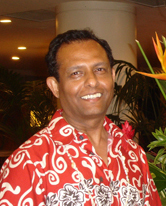
Narayan C. Debnath, Ph. D, D. Sc.
Professor and Chairman
Department of Computer Science, Winona State University
Winona, MN 55987, USA
and
President
International Society for Computers and Their applications (ISCA),
Cary, North Carolina, USA
Tel: (507) 457-5261
Ndebnath@winona.edu
http://Course1.winona.edu/Ndebnath
Dr. Narayan C. Debnath has been a Full Professor of Computer Science since 1989 and currently the Chairman of Computer Science at Winona State University, Minnesota, USA. He is also serving as the President of the International Society for Computers and Their Applications (ISCA). Dr. Debnath is a recipient of a Doctorate degree in Computer Science and a Doctorate degree in Applied Physics (Electrical Engineering). In the past, he served as the President, Vice President, and Conference Coordinator of the International Society for Computers and Their Applications (ISCA), and has been a member of the ISCA Board of Directors since 2001. He received numerous Honors and Awards. During 1986-1989, Dr. Debnath was a faculty of Computer Science at the University of Wisconsin-River Falls, USA, where he was nominated for the National Science Foundation Presidential Young Investigator Award in 1989.
Dr. Debnath has taught a wide range of undergraduate and graduate courses in computer science including Software Engineering, Software Testing, Theory of Computation, Compiler Design, and Principles of Programming Languages. He has made original research contributions on Software Engineering Models, Metrics and Tools, Software Testing, Software Management, and Information Science, Technology and Management. For the past several years, he has been working on research problems involving the development of software models, software complexity metrics and tools, Software testing theory, techniques and tools, Software design tools, techniques and environments, and Information technology and management. Dr. Debnath is an author or co-author of over 300 publications in numerous refereed journals and conference proceedings in Computer Science, Information Science, Information Technology, System Sciences, Mathematics, and Electrical Engineering. Since 2005, he has been serving as the Guest Editor of the special issues of the Journal of Computational Methods in Science and Engineering (JCMSE) published by the IOS Press, the Netherlands.
Professor Debnath has made numerous teaching and research presentations at various national and international conferences, industries, and teaching and research institutions in Asia, Australia, Europe, North America, and South America. He has been serving as an international teaching and research advisor/coordinator of the Master of Software Engineering Program at the National Universities in Argentina, South America, since 2000. He has offered courses and workshops on Software Engineering and Software Testing at the universities in South America, Asia, and Middle East.
Dr. Debnath served as the General Chair, Program Chair, invited Keynote Speaker, Tutorial Chair, and technical Track or Session Organizer and Chair of the international conferences sponsored by various professional societies including the IEEE, IEEE Computer Society, the Society of Industrial and Applied Mathematics (SIAM), International Association of Computer and Information Science (ACIS), International Association for Science and Technology in Education (IASTED), Arab Computer Society, and the International Society for Computers and Their Applications (ISCA). Dr. Debnath is a member of the ACM, IEEE Computer Society, Arab Computer Society, and a senior member of the ISCA.
The Bio-Logic of Artificial Creatures
Since the seminal conference of Karl SIMS at the SIGGRAPH’1994, a lot of researchers try to generate 3D animated objects able to adapt their morphologies but also their behaviours to the task they have to perform in a virtual environment. These artificial creatures are usually build by an evolutionary algorithm witch evolves the generator of the creature (the gene) according to a fitness given by a physical simulator. These creatures can be seen as the result of an assembly-process of blocks, or of the developmental-process of artificial cells in a virtual chemical and physical environment. Although these new beings own a very simple metabolism, they are still capable of transforming their local environment in order to grow and to piece together “logical organs”.
Through a selected collection of models and videos issued from different international research works, this talk will present the underlying mechanism of the incredible birth of these artificial creatures and their migrations between virtual worlds and reality. The design of these biologically inspired systems (some people discuss about “breeding such technologies”) can be applied to pure virtual artefacts, but has already been the source of some spectacular achievements in evolutionary robotics with prototypes capable of self-reproduction... or self-assembly.
This approach creates a very strong passion in the research community working on virtual worlds, because it should be the tomorrow’s matrix of complex, autonomous and adaptive systems for our virtual or real companions.
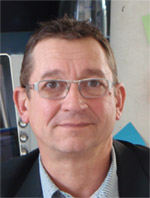
Yves Duthen, Prof. Dr.
University of Toulouse 1-Capitole - France
(+33) 05 61 55 8124
Yves.Duthen@irit.fr
http://www.irit.fr/-Publications-?code=120&nom=Duthen%20Yves
Prof. Dr. Yves Duthen is a Research Professor of Artificial Life and Virtual Reality at IRIT lab, University of Toulouse 1-Capitole (France). He received his Ph.D. degree from the University Paul Sabatier in 1983 and the “French Habilitation” degree in 1993 to become full Professor. He has worked in image synthesis during the 1980’s and focussed on Behavioural Simulation based on evolutionary mechanism since 1990. He has pioneered research in artificial life for building adaptive artificial creatures and focuses now on embedded metabolism with some very surprising results.
Dynamic Spectrum Access Wireless Networks: From Policies to Practice
Spectrum licensing and allocation policies are undergoing major changes in several countries. For example, in the new policies, spectrum is being thought of as property that can be leased when not being used by the license holder. Dynamic spectrum access (DSA) wireless devices will enable this functionality.
Academic research, industry, standards bodies and government regulations play an inter-related and profound role in shaping the challenges and opportunities in this topic. In this talk, we discuss some of the current and future research and technology issues in realizing DSA. Challenges at different layers of the network protocol stack and practical challenges will also be outlined. We will conclude with the implications of these issues on wireless communications standards (e.g., IEEE 802.22, LTE).
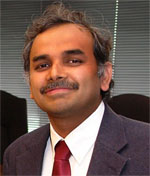
R. Chandramouli (Mouli)
Thomas Hattrick Chair Professor of Information Systems
Department of Electrical and Computer Engineering
Stevens Institute of Technology
Hoboken, NJ, USA
http://www.ece.stevens-tech.edu/~mouli
R. Chandramouli (Mouli) is the Thomas Hattrick Chair Professor of Information Systems in the Department of Electrical and Computer Engineering (ECE) at Stevens Institute of Technology and Co-Founder of inStream Media, LLC---a technology company offering social media security solutions. His research spans the areas of wireless networking and security, and social media security, forensics and analysis. Projects in these areas are supported by the National Science Foundation, National Institute of Justice, U.S. Department of Defense Agencies and industry. He was an invited member of the White House Communications Roundtable to give inputs on the National Wireless Initiative, Founding Chair of the IEEE COMSOC Technical Committee on Cognitive Networks (TCCN), TCCN's representative to the IEEE COMSOC Standards Board, Editor of the IEEE Journal on Selected Areas in Communications (JSAC) – Cognitive Radio Series, Editor of the Advances in Multimedia Journal, Associate Editor of the IEEE Transactions on Circuits and Systems for Video Technology, and is on the International Advisory Boards of several international conferences. Chandramouli is the recipient of an IEEE GLOBECOM 2008 Best Paper Award, IEEE CCNC 2006 Best Student Paper Award, NSF CAREER Award, and IEEE Richard E. Merwin Scholarship. His group has been developing and demonstrating a cognitive radio network prototype for dynamic spectrum access called SpiderRadio. inStream Media, LLC, a company that he co-founded commercializes his research on advanced statistical psycho-linguistic and information theoretic analytics for social network security and forensics.
Are Dynamic Spectrum Access Networks Secure?
Dynamic spectrum access (DSA) networking lets unlicensed wireless users occupy vacant radio spectrum bands when these bands are not in use by the primary user. While this paradigm has the potential to optimize spectrum usage, it also makes the networks vulnerable to unique threats. In this talk we will make the case that unless secure solutions are built from the ground up, DSA networks are vulnerable to several attacks. We will illustrate several such attacks and discuss some potential solutions.

K.P. (Suba) Subbalakshmi
Associate Professor at Stevens Institute of Technology,
Hoboken, NJ, USA
http://www.stevens.edu/suba/
Prof. K.P. (Suba) Subbalakshmi is an Associate Professor at Stevens Institute of Technology, Hoboken, NJ, USA. Her areas of interests include Dynamic Spectrum Access Networks, Internet and Media Forensics as well as Wireless Security. Her research is sponsored by the National Science Foundation, US National Institute of Justice, as well as several US DoD agencies. Prof. Suba is the North America Vice-Chair of the IEEE Technical Community on Cognitive Networks of IEEE COMSOC. She has also served as the Chair of the Security Special Interest Group of the Multimedia Communications Technical Committee (also a part of COMSOC). She has given several tutorials, key note addresses and participated in panel discussion in Cognitive Radio Networks. She has served/serves as a Guest/Associate Editor for several journals in her areas of interest.
Review of Sensing Techniques for Cognitive Radio Systems
In this presentation, a review of sensing techniques for cognitive radio systems will be presented. We will show also some new results on blind sensing techniques for cognitive radio systems based on the investigation of model selection and information theoretic measures such as Kullback-Leibler distance. Novel detection algorithms based on distribution analysis and sub-space estimation of the primary user received signal will be also detailed.

Prof. Aawatif Hayar
GREENTIC/ENSEM
Hassan II University
Casablanca, Morocco
Dr. Aawatif HAYAR received the “Agrégation Génie Electrique” from Ecole Normale Supérieure de Cachan in 1992. She received the “Diplôme d'Etudes Approfondies” in Signal processing Image and Communications and the degree of Engineer in Communications Systems and Networks from ENSEEIHT de Toulouse in 1997. She received with honors the Ph.D. degree in Signal Processing and Communications from Institut National Polytechnique de Toulouse in 2001. She was research and teaching associate at EURECOM’s Mobile Communication Department from 2001 to 2010. Aawatif Hayar is currently with GREENTIC R&D Organization (Morocco) as General Secretary and expert in cognitive green ICT field. She has also joined in 2011 the engineering school ENSEM at the University Hassan II Casablanca in Morocco. Aawatif Hayar was a Guest Editor of Elsevier Phycom Journal Special issue on Cognitive Radio Algorithms and System Design in 2009 and General Co-chair of Crowncom2010 dedicated to cognitive radio systems and IW2GN2011 dedicated to wireless green systems. She is also expert at the european commission level for cognitive and UWB systems. Aawatif Hayar received best student paper award at CogArt2010 and has a patent in cognitive radio field on “Process for sensing vacant bands over the spectrum bandwidth and apparatus for performing the same based on sub space and distributions analysis”.
Multimedia standards. History. State of Art
Keywords: Multimedia Standards, MPEG, W3C, Interactive TV, Video-Stream Filtering, Audiovisual Media, Metadata
Description of the tutorial
- Motivation---“Why is this topic important?”
Standardization is important. It always has been. Even in ancient times, units of measure had to be established and held as the standard. No other technology than the MPEG and W3C standards has the potential to become as deeply developed and widely supported by multiple industries, vendors and service providers, and to be trusted by end users with their multimedia needs.
- Objectives---“Why should one attend this tutorial?”
The aim of this tutorial is to review some of the standards connected with multimedia and their metadata. Using and working with movies, video, animation, music, voice, web application everybody need to use and understood the multimedia standards. MPEG, which stands for Moving Picture Experts Group, is the name of a family of standards used for coding audio-visual information in a digital compressed format. The major advantage of MPEG compared to other formats is that MPEG files are much smaller for the same quality. W3C standards define an open Web Platform for application development that has the unprecedented potential to enable developers to build rich interactive experiences, powered by vast data stores that are available on any device. The tutorial will cover also open standards for interactive TV, audiovisual media, metadata standards, museum, archives, and libraries metadata.
- Key takeaway messages---“What can the attendees learn from this tutorial?”
The main standards for multimedia. Many demos will be provided.
- Target audience and prerequisite knowledge of audience---“Who should attend this tutorial?”
Computer science Ph.D. students, researchers, people willing to work with multimedia and their metadata. Not special preliminarily knowledge is required.
- Outline---“What does the speaker plan to give in the tutorial?”
- MPEG (Moving Picture Experts Group - Multimedia Framework) family standards.
- MPEG-1, the standard for such products as Video CD and MP3 are based;
- MPEG-2, the standard for such products as Digital Television set top boxes and DVD are based;
- MPEG-4, the standard for multimedia for the fixed and mobile web;
- MPEG-7, the standard for description and search of audio and visual content;
- MPEG-21, the Multimedia Framework;
- MPEG-C, a collection of Video specific standards;
- MPEG-D, a collection of Audio specific standards;
- MPEG-DASH, the standard for video streaming over the internet;
- MPEG-E, a standard (M3W) providing support to download and execution of multimedia applications;
- MPEG-H, a standard (HEVC) that will provide significantly increased video compression performance compared to AVC;
- MPEG-M, a standard (MXM) for packaging and reusability of MPEG technologies;
- MPEG-U, a standard for rich-media user interface;
- MPEG-V, a standard for interchange with virtual worlds.
- Reconfigurable Video Coding (RVC) standard
- W3C Standards
- Web Design and Applications involve the standards for building and rendering Web pages, including HTML5, CSS, SVG, Ajax, and other technologies for Web Applications;
- Web Architecture focuses on the foundation technologies and principles which sustain the Web, including URIs and HTTP;
- Semantic Web technologies enable people to create data stores on the Web, build vocabularies, and write rules for handling data. Linked data are empowered by technologies such as RDF, SPARQL, OWL, and SKOS;
- XML Technologies including XML, XQuery, XML Schema, XSLT, XSL-FO, Efficient XML Interchange (EXI), and other related standards;
- Web of Services refers to message-based design frequently found on the Web and in enterprise software. The Web of Services is based on technologies such as HTTP, XML, SOAP, WSDL, SPARQL, and others;
- Web of devices. This includes Web access from mobile phones and other mobile devices as well as use of Web technology in consumer electronics, printers, interactive television, and even automobiles;
- Browsing and authoring tools. Web agents are intended to serve users.
- Open standards for interactive TV (iTV). MHEG (Multimedia and Hypermedia Information Coding Expert Group), DAVIC (Digital Audio-Video Council), Java TV (an extension of the Java platform), MHP (Multimedia Home Platform), GEM (Globally Executable Multimedia Home Platform), OCAP (OpenCable Application Platform), ACAP (Advanced Common Application Platform).
- Standards in the audiovisual media. DPX (Digital Picture Exchange), MXF (Material Exchange Format), Engineers (SMPTE), DCP (Digital Cinema Package), Dublin Core, EBU P Meta
- Metadata standards: Dublin Core, TEI (Text Encoding Initiative), METS (Metadata Encoding & Transmission Standard), MODS (Metadata Object Description Schema), EAD (Encoded Archival Description), LOM (Learning Object Metadata) standard, MARC Standards, VRA Core Categories, CSDGM (Content Standard for Digital Geospatial Metadata)
- Standards for museum metadata: Categories for the Description of Works of Art (CDWA), Museumdat, Object ID, SPECTRUM, Light Information Describing Objects (LIDO), FDAGuide
- Standards for archives: General International Standard Archival Description: ISAD(G), Describing Archives: A Content Standard (DACS), Encoded Archival Description – EAD, Reference Model for an Open Archival Information System – OAIS
- Standards for libraries: Standard Functional Requirements for Bibliographic Records – FRBR, MAB2, MARC 21 (MARC), Standard Metadata Encoding & Transmission Standard – METS, MODS, MIDAS
- MPEG (Moving Picture Experts Group - Multimedia Framework) family standards.
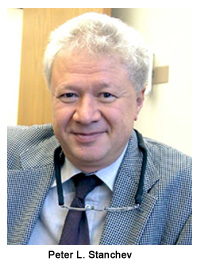
Peter Stanchev
Professor at Kettering University, Michigan, USA
810 762 7927 Voice
810 762 9796 Fax
email: pstanche@kettering.edu
website: www.kettering.edu/~pstanche
Professor, Chair of the Information Systems Department
Institute of Mathematics and Computer Science
Bulgarian Academy of Science
Guest professor, Institute of Information Science and Technologies
Italian National Research Council
Peter Stanchev is currently professor at Kettering University, Flint, Michigan, USA and professor and chair at the Institute of Mathematics and Informatics, Bulgarian Academy of Sciences, Sofia, Bulgaria. He publish 2 books, more than 200 chapters in monographs, journal and conference peer-reviewed papers, more than 200 conference papers and seminars, and have more than 600 citations. His research interests are in the field of multimedia systems, database systems, multimedia semantics, and medical systems. Serving also on many database and multimedia conference program committees, he is currently editor of chief and on the editorial boards of several journals. He has presented similar tutorial on several conferences.